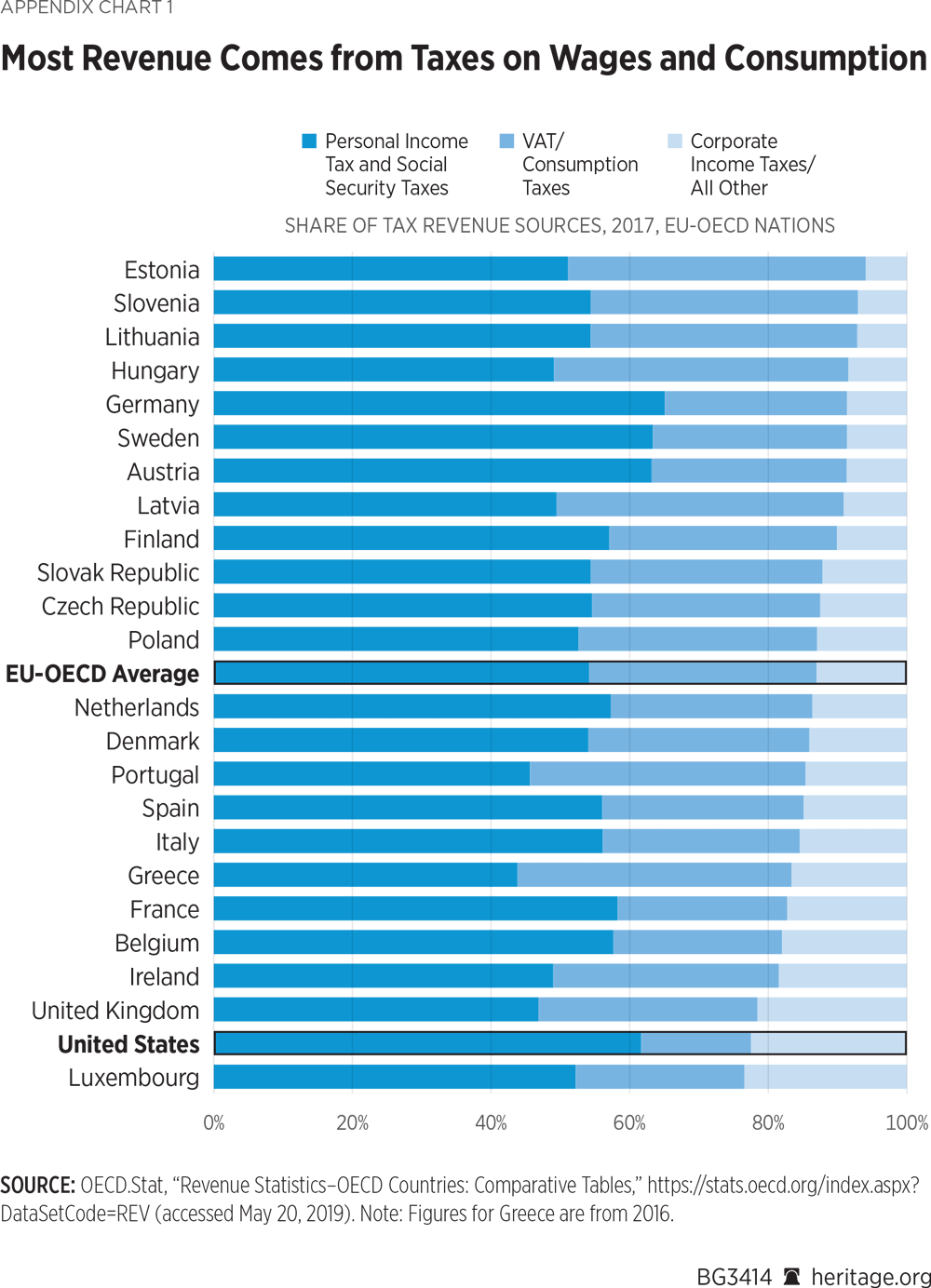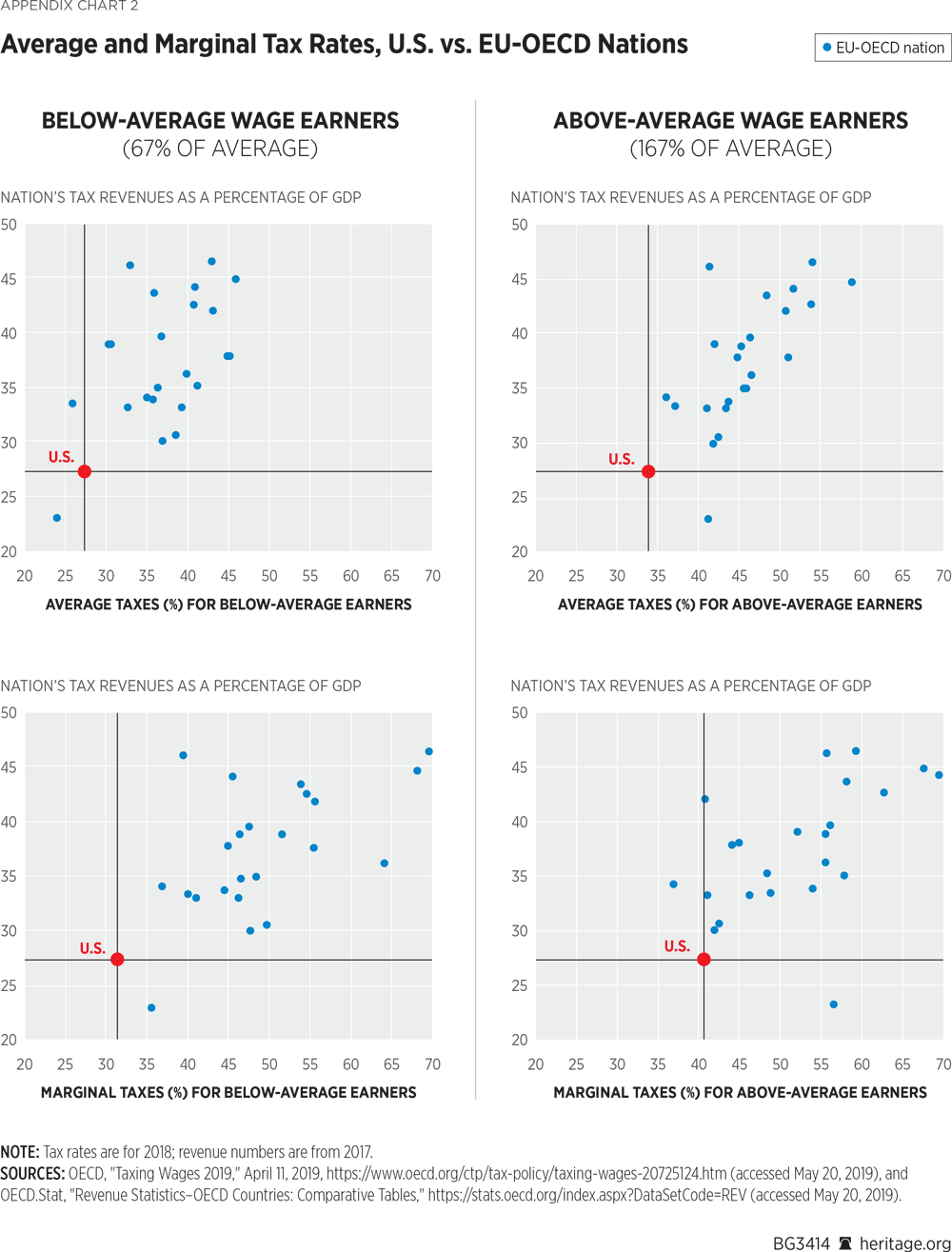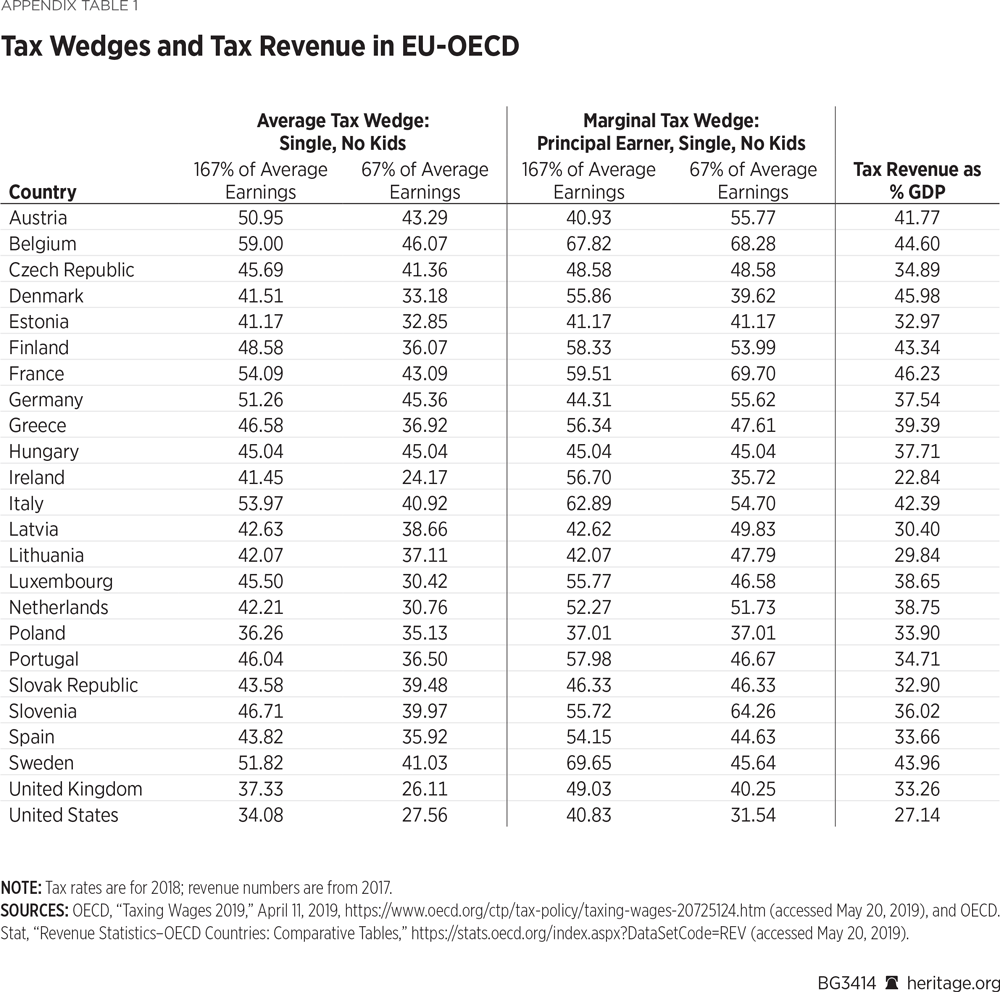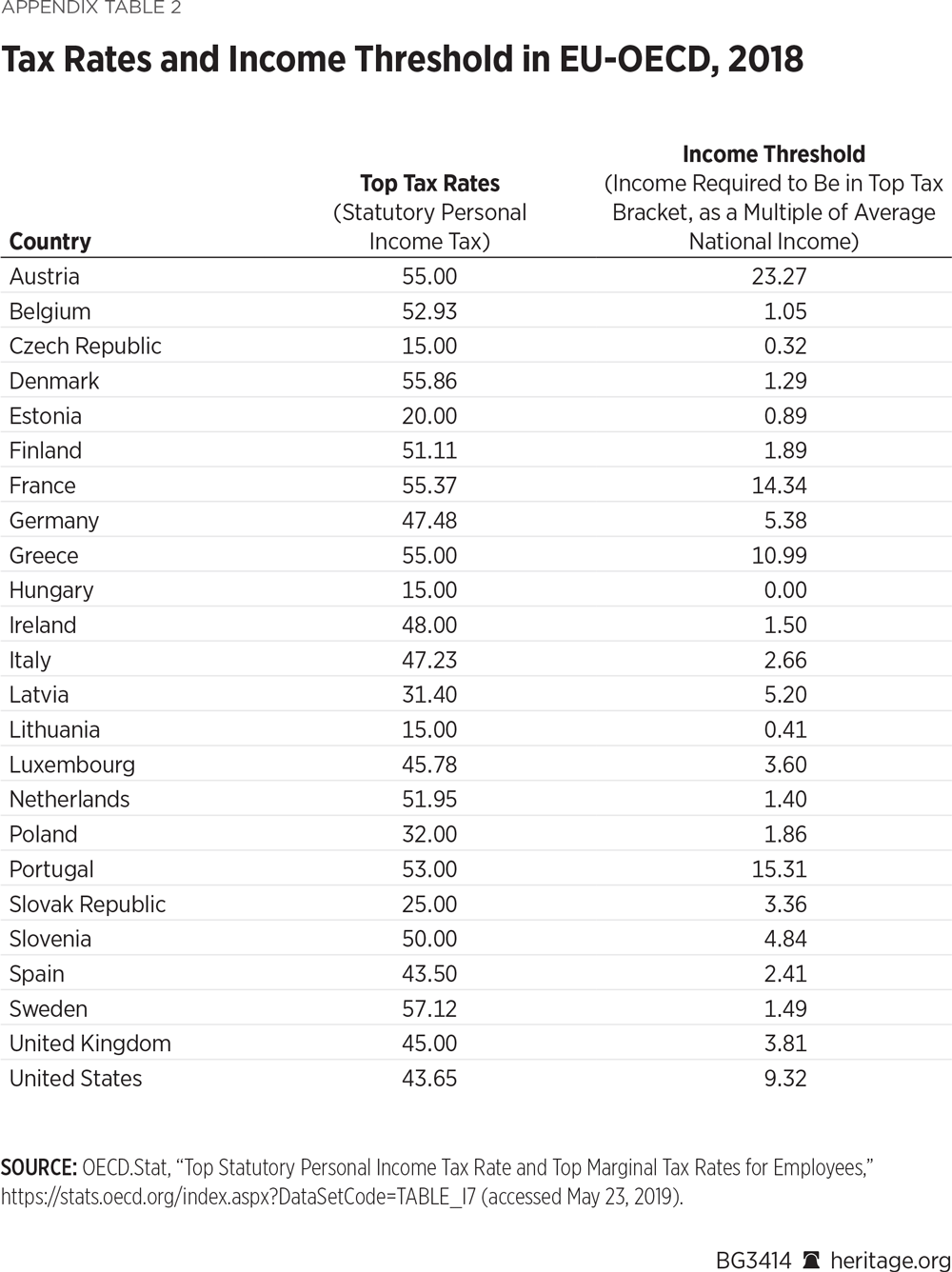Washington’s finances cannot be fixed without a significant reduction in the growth rate of spending—or large tax increases on the middle class. The Congressional Budget Office estimates that spending will exceed revenues by $900 billion in 2019. The actual number will be even larger if Congress passes emergency or infrastructure spending packages this year.REF If current policy continues, in 10 years, the 2029 budget deficit will likely exceed $2 trillion in that year alone.REF As a matter of mathematical certainty, large and growing budget deficits cannot continue forever.REF
Politicians, both Republicans and Democrats, have shown little desire to control the rate of spending growth. Recent proposals, such as Medicare for All, free college, a national job guarantee, paid family and medical leave, and the Green New Deal, are conservatively estimated to cost more than $50 trillion over 10 years, or about $5 trillion a year.REF A $5 trillion increase in outlays would more than double the $4.4 trillion 2019 federal budget.
Without controls on spending growth, Congress will eventually raise taxes. Popular proposals to raise taxes on the rich are insufficient to cover the current level of government spending, let alone the $50 trillion European-style welfare state agenda. Combined, the popularly discussed wealth tax, 70 percent top tax rate, and a financial transactions tax would, in the most optimistic scenarios, raise about $300 billion a year.REF That is about a third of the current budget deficit, 15 percent of the projected current-policy 2029 budget deficit, or just 6 percent of the new spending called for by prominent progressives.
Although few countries have all the programs currently being proposed by the progressive Left in the U.S., expansive government services and government-run health care exist around the world, especially in Europe. If Americans want European-style government services, they should be ready for European-style taxes. European welfare states do not rely on overly progressive tax systems. Instead, they use broad-based taxes like the value-added tax (VAT), high payroll taxes, and relatively flat income taxes, which fall primarily on taxpayers in the middle of the income distribution.
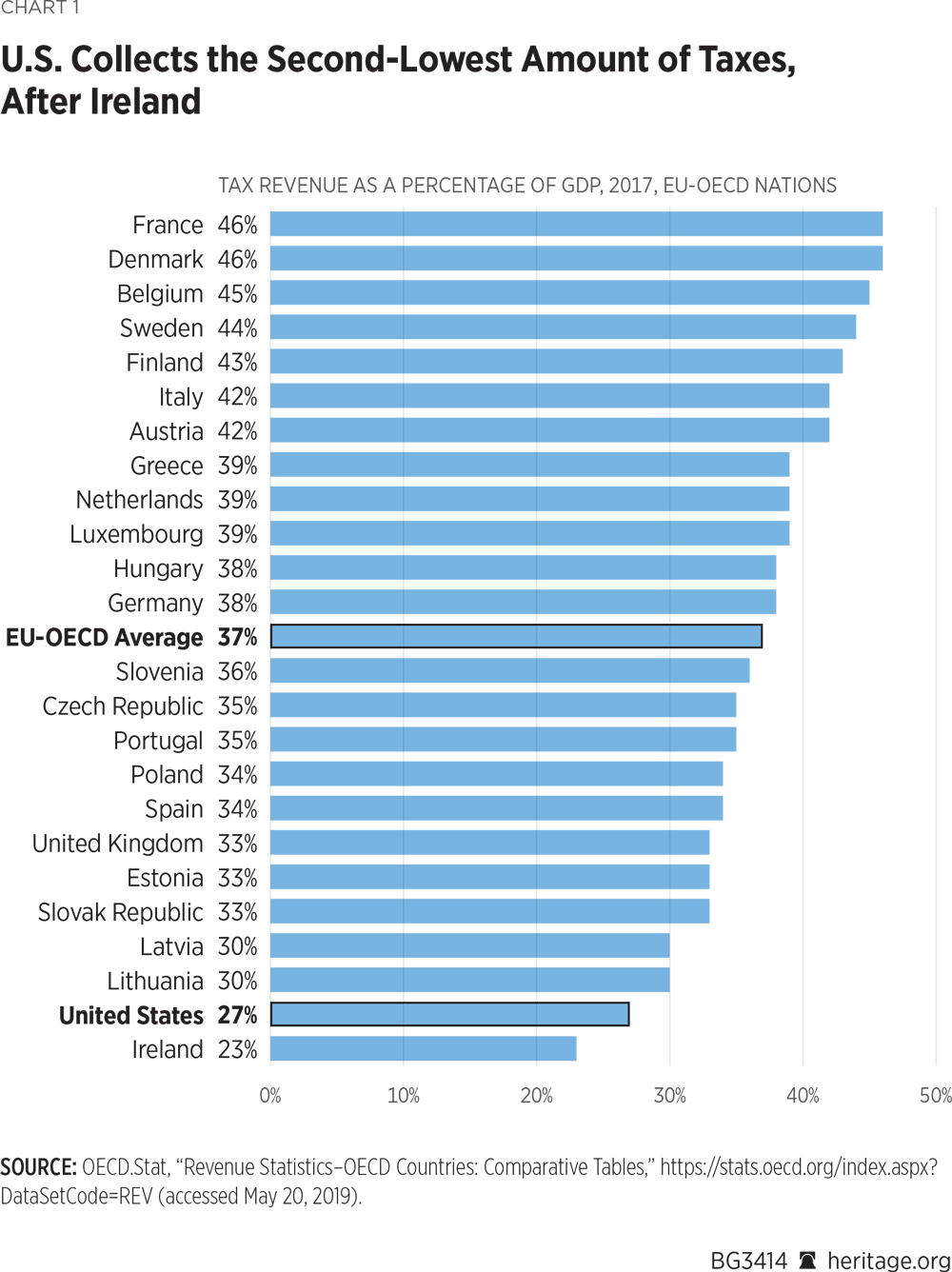
If Congress continues to look to Europe as a model for its spending policy, Congress will eventually adopt the European tax policy, too. On average, about 37 percent of all economic activity is taxed by the governments of the 23 countries that are members of the European Union as well as of the Organization for Economic Co-operation and Development (EU-OECD).REF In the U.S., taxes consume 27 percent of economic output. To raise large amounts of tax revenue, many of these countries implement marginal wage tax rates of 50 percent or more on all income earned over $37,000 a year, a below-average wage. Higher incomes are taxed at even higher rates. European-style sales taxes on goods and services, called VATs, have rates above 20 percent, on average. Such high taxes would not be a desirable outcome for any American’s economic well-being, but voters and the Congress they elect should be adequately acquainted with the reality of funding big government.
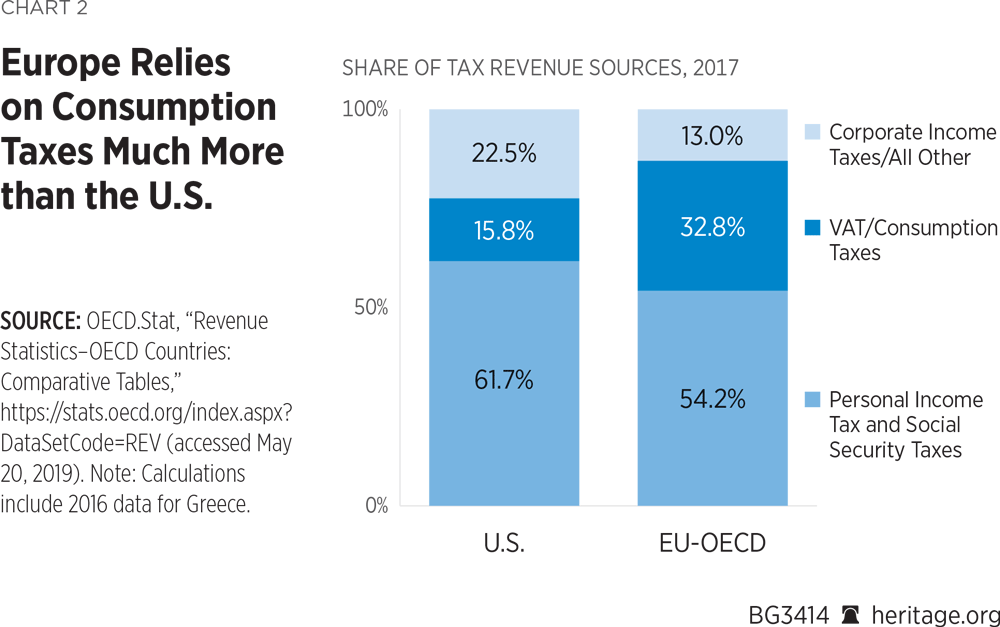
How Do U.S. Taxes Compare to Europe?
The United States is not a high-tax country compared to our European counterparts. The total level of taxation is important because it represents a sort of average, countrywide tax rate and shows how much of the economy is driven by politics rather than markets. Across the EU-OECD, seven countries have governments that tax over 40 percent of the economic activity. (See Chart 1.) In the United States, federal, state, and local taxes consume about 27 percent of output (gross domestic product (GDP)).
The composition of how that revenue is raised also varies greatly across the EU-OECD. Chart 2 shows that individual income taxes, payroll taxes, and VATs comprise the largest portions of most countries’ tax revenue. The breakdown by each country can be found in the appendix.
Taxing Wages to Fund Big Government
Wage taxes make up the single largest share of tax revenue for every EU-OECD country. Wage taxes can be expressed as the marginal and average tax wedge on labor income, by combining income taxes, employee payroll taxes and employer payroll taxes at each level of government. Although the employer legally writes the check for some payroll taxes, economists generally agree that workers bear the entire cost of the payroll tax through lower wages.
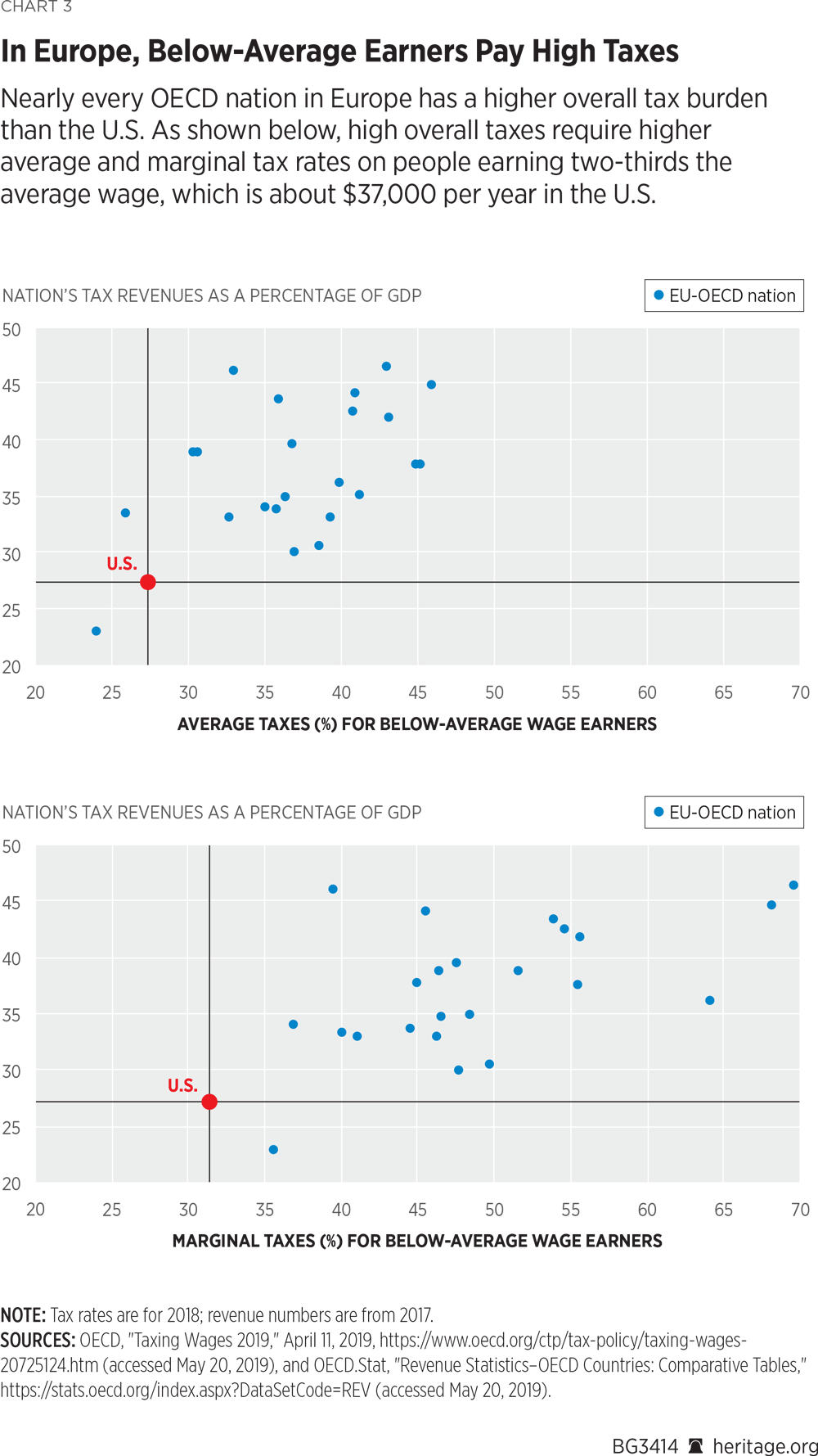
The marginal tax wedge represents how much tax a worker must pay on the next dollar of income earned. If a worker is considering driving for Uber on the weekends for a little additional income, the marginal tax wedge shows how much of that additional income the worker would get to keep. High marginal taxes reduce the incentive for him to take the extra job or work as hard to get a raise or promotion.
The marginal tax on wages is above 40 percent on workers earning $37,000 a year (67 percent of the country’s average earnings) in all but three of the EU-OECD countries for a single worker with no children.REF In the United States, a single person making $37,000 a year faced a marginal tax wedge of 32 percent in 2018, lower than in any EU-OECD country. In eight countries, marginal taxes are above 50 percent for the same below-average wage worker. In France and Belgium, marginal rates on below-average incomes are 70 percent and 68 percent, respectively. Chart 3 shows that the marginal tax wedge tends to be higher in countries with higher tax burdens measured by tax revenues as a percent of GDP in 2017.
The average tax wedge divides total taxes paid on wages by what the worker would have earned without taxes. Chart 3 shows that over one-third of potential income is taxed away in all but three countries for a single worker with no children making 67 percent of the country’s average earnings. In eight countries the average tax rate is above 40 percent. The U.S. has the third-lowest average tax wedge of 28 percent, behind Ireland (24 percent) and the U.K. (26 percent).
Workers earning above the average wage pay even higher taxes than low-wage workers in most countries across Europe. The marginal tax on wages is above 50 percent on workers earning close to $92,000 (167 percent of the average wage) in 13 of the EU-OECD countries for a single worker with no children.REF The United States had the second-lowest marginal tax wedge of 41 percent, behind Poland (37 percent) in 2018. Appendix Chart 2 shows three countries have marginal taxes above 60 percent, and Sweden’s top rate is just shy of 70 percent for workers earning 167 percent of the average wage.
Measured by the average tax wedge for above-average-wage workers, over half of the income that workers making $92,000 a year earn is taxed away in six countries. In all but three countries, the average tax rate is above 40 percent. The U.S. has the lowest average tax wedge of 34 percent.
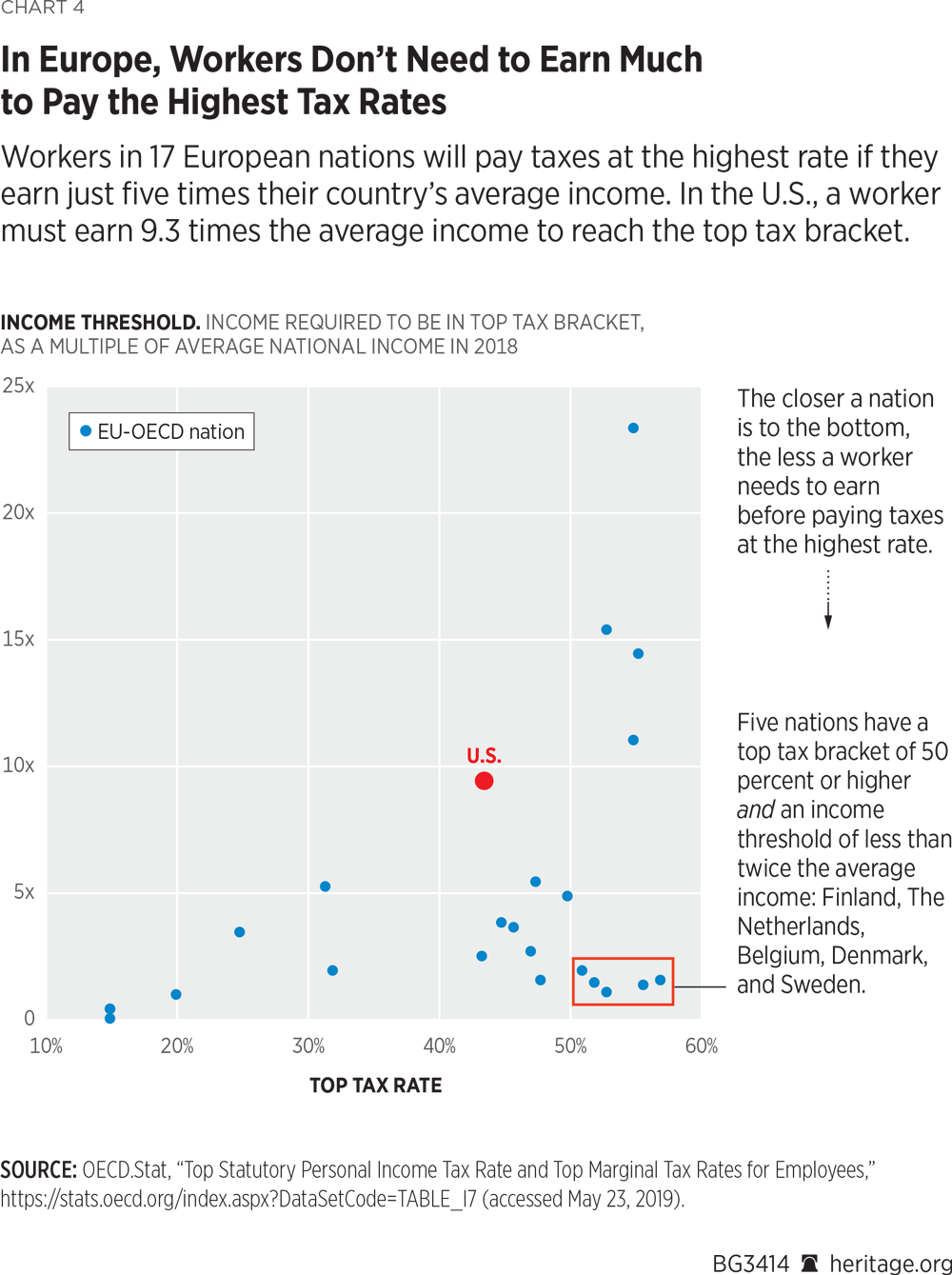
Looking just at income taxes (excluding payroll taxes), many EU-OECD countries apply their top marginal income tax rates to average or close to average income earners. As shown in Chart 4, in 11 EU-OECD countries, top combined federal and sub-federal income tax rates apply to people with less than two times the average country wage. In the U.S. that would mean individuals making more than about $110,000 a year would face a federal marginal income tax rate 13 percentage points higher than they pay currently. The U.S. has the fifth-highest income tax threshold among the EU-OECD. Across Europe, countries apply their highest tax rates to a much larger share of their citizen’s income than in the U.S.
Compared to the U.S., top combined marginal income tax rates are higher in 15 of the 23 EU-OECD countries. Sweden, Denmark, Greece, France, and Austria all have top rates of 55 percent or higher. Five nations have a top tax bracket of 50 percent or higher and an income threshold of less than twice the national average. Sweden and Denmark’s 57 percent and 56 percent marginal rates apply to incomes that are 1.5 percent and 1.3 percent of the average, respectively.
A 70 percent tax rate on incomes over $10 million, as has been proposed by some U.S. lawmakers, would make the U.S. an even more extreme outlier. The proposal would mean the U.S. would have the highest marginal tax rate among our European counterparts and the high rate would apply to incomes about 180 times the national average.REF Such highly progressive systems do not raise much revenue, if any, and create economically destructive incentives for the most productive people in the country.REF
Countries that choose to have large social and redistributive programs cannot rely only on taxes on the rich for funding. As the data show, countries that have larger governments than the U.S. use high taxes on low-income and middle-class workers to foot the bill.
Taxing Consumption to Fund Big Government
Across all levels of government, the U.S. relies on consumption taxes much less than any EU-OECD country. Chart 2 shows that 15.8 percent of all U.S. state and federal revenue comes from taxes on goods and services. Across Europe, consumption taxes are the largest single source of revenue, comprising 32.8 percent.
The United States is the only country in the OECD that does not use a VAT to raise a majority of consumption tax revenue. The VAT is a type of national sales tax that is collected by businesses at each stage of production, rather than at the cash register. In the U.S., most of the consumption tax revenue is collected by state governments through a sales tax at the point of sale. The U.S. federal government does not collect a broad-based consumption tax. Across all countries, a small portion of consumption tax revenue is raised through excise taxes on specific products, like cigarettes and alcohol.
In addition to higher wage tax rates than the U.S., EU-OECD countries also have significantly higher consumption tax rates. The average EU-OECD standard VAT rate was 21.8 percent in 2016.REF The average state and local sales tax rate across the 50 U.S. states and the District of Columbia was 6.4 percent in the same year.REF
VATs have at least three features that make them important components of paying for big government. First, lawmakers are able to raise more revenue with a VAT than they can with wage and corporate income taxes alone. Because the VAT is such an efficient way to raise revenue, compared to most other taxes, lawmakers can increase the size of government well beyond the size that could be supported by less-efficient income taxes alone.REF VATs are also not always as visible as sales taxes because they are collected at each stage of production and often included in the posted price rather than added on at the point of sale.
Second, VATs are another way to raise taxes on lower-income and middle-class taxpayers because everyone has to buy goods and services. Unlike income taxes, where large portions of income can be excluded from tax, and rates can be set higher for high-income earners, everyone pays the same VAT rates. The VAT distributes the tax burden more evenly across all taxpayers. Because many observers wrongly think the VAT is regressive, it is often paired with large redistributive policies to compensate low-income earners for the higher taxes, further growing the size of government.REF
Third, the VAT is not only paid by working-age income earners but also by non-income-earning retirees. In aging Western countries, where social programs for retirees continue to consume larger portions of current government expenditures, VATs are a convenient way to make retirees shoulder some of the burden of paying for their overpromised benefits.REF
The VAT is often sold politically as a revenue-neutral substitute for other unpopular or economically harmful taxes. While such a tax swap is an interesting thought experiment, in the real world, a VAT usually leads to higher income taxes and overall higher government spending.REF Historically, the VAT is associated with growing the size and scope of government, not making it more efficient.REF
A Progressive Road Map to Taxing the Middle Class
Relative to the EU-OECD average, the U.S. is the second-lowest tax country by revenue raised as a percent of GDP. However, the true level of taxation is the level of spending. Even after accounting for large deficits, the U.S. is the fourth-smallest government when measured by expenditures as a percent of GDP, compared to the EU-OECD.
Simply raising enough tax revenue in the U.S. to meet current spending will require significant tax increases. Paying for even a small portion of the progressive agenda will require tax increases on the order of double or triple what most Americans pay today.
There is simply not enough money held or earned by wealthy taxpayers to fund government spending at levels seen across Europe. For the government to tax and spend half or more of all economic output each year, it must employ high taxes that fall squarely on the majority of citizens. Looking to Europe, it is evident that high taxes on the rich alone are not sufficient to pay for the progressive agenda. Big government requires high taxes on consumption and high taxes on lower-income and middle-class wages, in addition to other taxes on businesses and property. As a matter of arithmetic, typical taxpayers must be on the hook for expansive government spending.
The progressive rhetoric about raising taxes on the rich is only half the political story. U.S. tax history lends further color to the progressive strategy to leverage narrow taxes on the rich into mass taxes on everyone. First, raising taxes on the rich provides political cover to later raise taxes on middle-income earners. Tax historian Joseph Thorndike explains that high marginal income tax rates in the New Deal era were used “to help justify regressive consumption taxes on alcohol and tobacco, which supplied anywhere from a third to half of federal revenue during the early 1930s.”REF Again in the 1940s, he explains that high marginal tax rates of 90 plus percent were used to provide political cover for a “dramatic downward expansion of the income tax.”REF
Prominent supporters of more federal spending on health care, education, environmental policy, and income supports point to America’s history of higher top marginal tax rates as evidence that the country should do it again. What they leave out of the story is that high-income taxpayers did not actually pay more in total taxes when top rates were as high as 90 percent. Avoidance was high, and the tax base was narrow and easily planned around.REF Historically, high tax rates have not only been about making the rich pay more; instead, high marginal tax rates help build political support for more taxes on everyone else. As is clear when looking at the European fiscal model, large welfare states cannot be sustained by primarily taxing any narrow segment of the population. Everyone must pay for big government.
The cost of high taxes is more than the direct costs; all taxes have economic costs, too, even if they are turned into widely available benefit programs. The economic cost of taxes ultimately affects citizens through lower wages, increased prices, and less economic opportunity. Businesses and capital gains taxes decrease investment, which slows wage growth and job creation.REF Wage taxes often mean that people work fewer hours and choose to be less innovative, slowing entrepreneurship.REF Consumption taxes increase prices, decrease consumer’s standards of living, and negatively affect employment and investment incentives. Big government requires high taxes, and high taxes have large negative effects on the well-being of every American.
A Different Path
If American fiscal policy continues to follow the lead of Europe, the tax policies of Europe will invariably have to follow. Americans still have a choice. By not adding any new spending programs and reforming the largest drivers of future deficits—Medicare, Medicaid, Obamacare, and Social Security—it is possible to balance the budget and begin paying down the debt over time. The Heritage Foundation’s 2020 Blueprint for Balance presents one road map to balancing the budget without raising taxes by 2029.REF
Even in the absence of new federal spending programs, tough choices must be made. The rate of growth of federal spending is currently growing faster than both the economy and tax collections. If current spending growth is not slowed down, taxes will eventually increase significantly for all taxpayers. There are no other sustainable options.
Adam N. Michel is Senior Policy Analyst in Fiscal Policy in the Grover M. Hermann Center for the Federal Budget, of the Institute for Economic Freedom, at The Heritage Foundation.
Appendix
